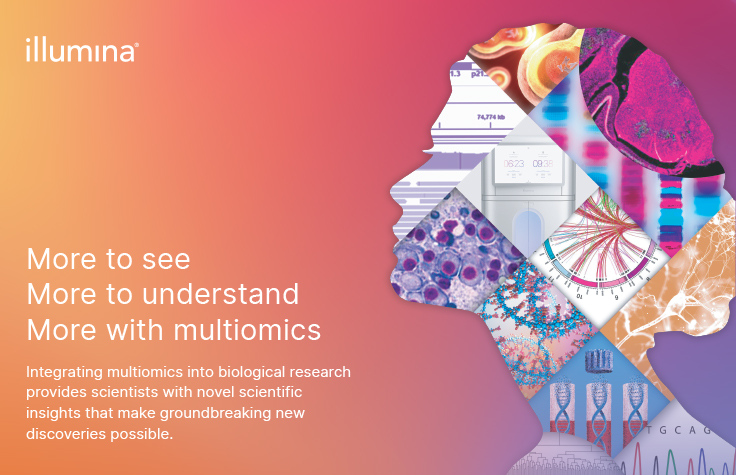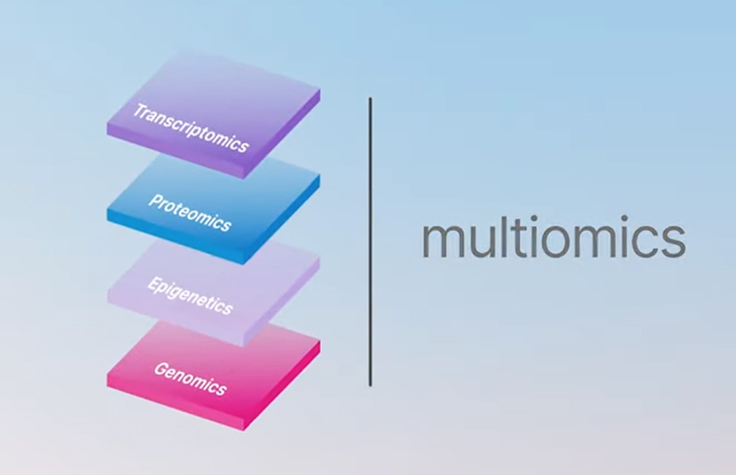Multiomics
Multiomics offers a holistic view of biology
Integrating methods for deeper insights and discoveries
What is multiomics?
Multiomics (multiple omics) provides an integrated approach to power discovery across multiple levels of biology. By combining data from genomics, transcriptomics, epigenetics, and proteomics, researchers can achieve a more comprehensive understanding of molecular changes contributing to normal development, cellular response, and disease.
Multiomics can also combine separate omic data from past experiments, known as in-silico multiomics, to efficiently analyze novel biological relationships. Regardless of the method chosen, Illumina offers solutions powered by NGS to enable your next multiomics profiling studies and analyses.

Multiomics multiplies your discovery power
See how you can use multiomics to better connect genotype to phenotype and obtain a full cellular readout not found through single omics approaches.
Download in-depth eBookExpand your research across multiple omes
Genomics
Focus on the structure, function, evolution, mapping, and editing of information coded within an organism’s DNA.
Transcriptomics
Study the complete set of RNA transcripts produced by the genome.
Proteomics
Evaluate protein expression for a better understanding of cellular function and prediction of therapeutic responses.
Epigenomics
Examine heritable changes in gene expression activity caused by factors other than DNA changes.
Leveraging bulk to targeted methodologies for more powerful discoveries
Perform multiomic experiments using NGS-based solutions to find novel links between biological entities, identify biomarkers, profile mutations and other phenotypes, and improve discovery of new therapies. Illumina offers comprehensive solutions across biological resolutions from broad bulk analysis to targeted single cells. For more details, visit our multiomic methods comparison guide.
Comprehensively analyze bulk cell populations or tissue sections
Explore how pooling cells or tissue populations can be used to analyze protein and transcriptional activity within a single workflow using bulk epitope and nucleic acid sequencing (BEN-Seq).
Achieve high resolution data with single-cell analysis
Measure gene regulatory networks and gain insights into cell heterogeneity by combining transcriptomics and epigenomics in a singular molecular readout using ATAC-Seq as found in this technical note.
See how cellular indexing of transcriptomes and epitopes sequencing (CITE-Seq) can provide proteomic and transcriptomic data in a single run powered by NGS.
Spatially map transcriptional activity in tissues
Learn key benefits of spatial transcriptomics, which localizes gene expression within intact tissues for a better understanding of structure and activity.

Decoding complex pathways with 5-base analysis for multiomic insights
In this eBook, discover the value of studying the methylome and genome, together, to unravel the mechanisms of genetic disease, cancer, and other complex diseases.
Download eBookStreamline your multiomic workflows
Multiomic workflows generally start with nucleic acid isolation using a kit of your choice, followed by creation of libraries for sequencing. Results are analyzed using bioinformatics software and are dependent on the sample type, instrument, analytical method, and desired insight. A general overview is provided along with featured products to help visualize multiomic workflows. Explore the sample workflows and solution options for bulk sequencing, single-cell, and spatial sequencing methods.
Prepare libraries
DNA library preparation
Explore flexible and efficient DNA library prep for a broad range of applications. Illumina DNA PCR Free Prep and Illumina DNA Prep with Enrichment offer a high-performing, fast, and integrated workflow for sensitive applications.
Illumina Single Cell 3' RNA Prep
Accessible and highly scalable single-cell RNA-Seq solution for mRNA capture, barcoding, and library prep with a simple manual workflow that doesn't require a cell isolation instrument.
Illumina Total RNA Prep with Ribo-Zero Plus
Provides exceptional performance for the analysis of coding and multiple forms of noncoding RNA.
Illumina Stranded mRNA Prep
Offers a streamlined RNA-Seq solution for clear and comprehensive analysis across the transcriptome.
Sequence
Production-scale sequencers
Access multiple omics on a single instrument. Deep and broad coverage through advanced applications for a comprehensive view of omic data with the NovaSeq X Series and NovaSeq 6000 Sequencing System.
Benchtop sequencers
Flexible, affordable, and scalable to help both new and experienced users achieve fast turnaround times and reduced operating costs with NextSeq 1000 and NextSeq 2000 Sequencing Systems.
Analyze and interpret data
Illumina Connected Analytics
A secure genomic data platform to operationalize informatics and drive scientific insights.
DRAGEN secondary analysis
Accurate, comprehensive, and efficient secondary analysis of next-generation sequencing data.
Correlation Engine
Correlation Engine is an interactive knowledge base where users can put their private multiomic data into biological context with highly curated public multiomic data.
Illumina Connected Multiomics
A powerful and scalable analysis environment for interpreting and visualizing multiomic data.
Simplify analysis for multiomic interpretation and insight
Following sequencing, data analysis provides the key step to allow biological interpretation of samples. In general, the multiomics data analysis pipeline consists of three phases, with available software for each step. The approach used will depend on the research objective and the omes you are studying.
Primary analysis
Also referred to as base calling, primary analysis coverts data into base sequences (A, T, C, or G) as a raw data file in binary base call (BCL) format and is performed automatically on Illumina sequencers.
Secondary analysis
The BCL sequence file format requires conversion to FASTQ format for use with Illumina, user-developed, or third-party secondary analysis tools. Illumina DRAGEN secondary analysis features tools for every step of most secondary analysis pipelines.
Tertiary analysis
Illumina Connected Multiomics is a powerful and scalable analysis environment for interpreting and visualizing multiomic data.
Correlation Engine is an interactive knowledge base where users can put their private multiomic data into biological context with highly curated public multiomic data.

Make more discoveries with the NovaSeq X Series and 25B Flow Cell
Step up your multiomics research with the NovaSeq X Series combined with the 25B Flow Cell. Achieve high-quality data with low-cost workflows to accelerate and broaden your research.
Download flyerIllumina Connected Multiomics
Illumina Connected Multiomics is the first fully integrated multiomic and multimodal analysis software from Illumina, enabling seamless sample-to-insights workflows. Researchers can explore multiomic data, reveal deeper biological insights, and accelerate discoveries.
- Powerful analysis: Attain reliable results with robust statistical methods
- Interactive visualizations and intuitive interface: Easily generate information-rich and publication-ready visualizations without the need for additional bioinformatics expertise
- Deeper biological context: Link results to curated biological knowledge (cell types, feature sets) for deeper interpretation. Make more informed decisions, identify meaningful biological patterns, and accelerate discoveries with greater confidence.
Frequently Purchased Together
Additional Resources
Advancing cancer research with multiomics
Learn how researchers at the Ontario Institute for Cancer Research and United Health Network are linking the causes and consequences of complex phenotypes through multiomics to enable discoveries that weren’t possible before.
Success with single-cell multiomics
Leading experts in single-cell multiomics share their successful experiences using multiomics as well as how they overcame challenges and visualized data.
Multiomics with NGS-based proteomics
Explore how multiomics can now include proteomics using NGS-powered solutions from Illumina.
